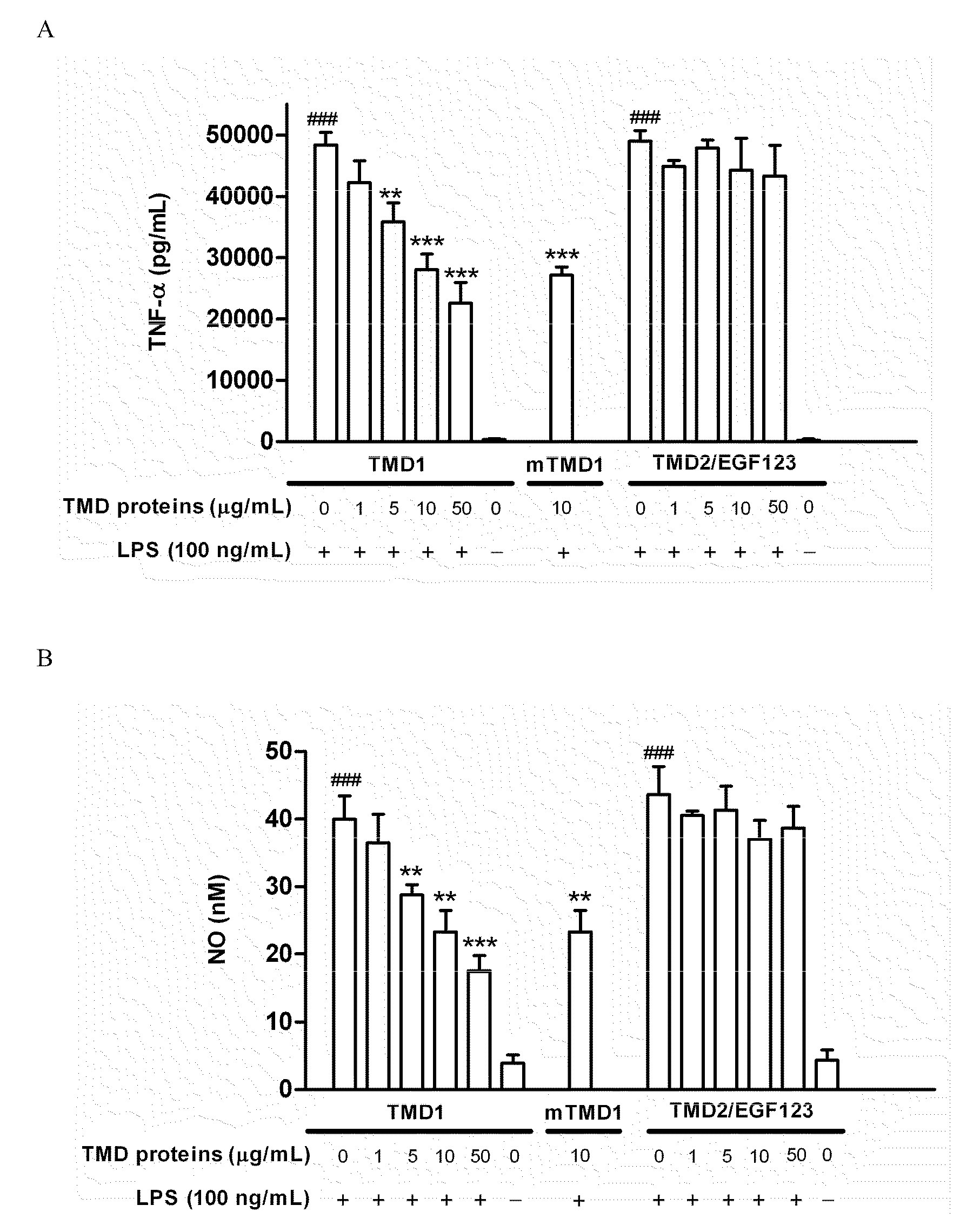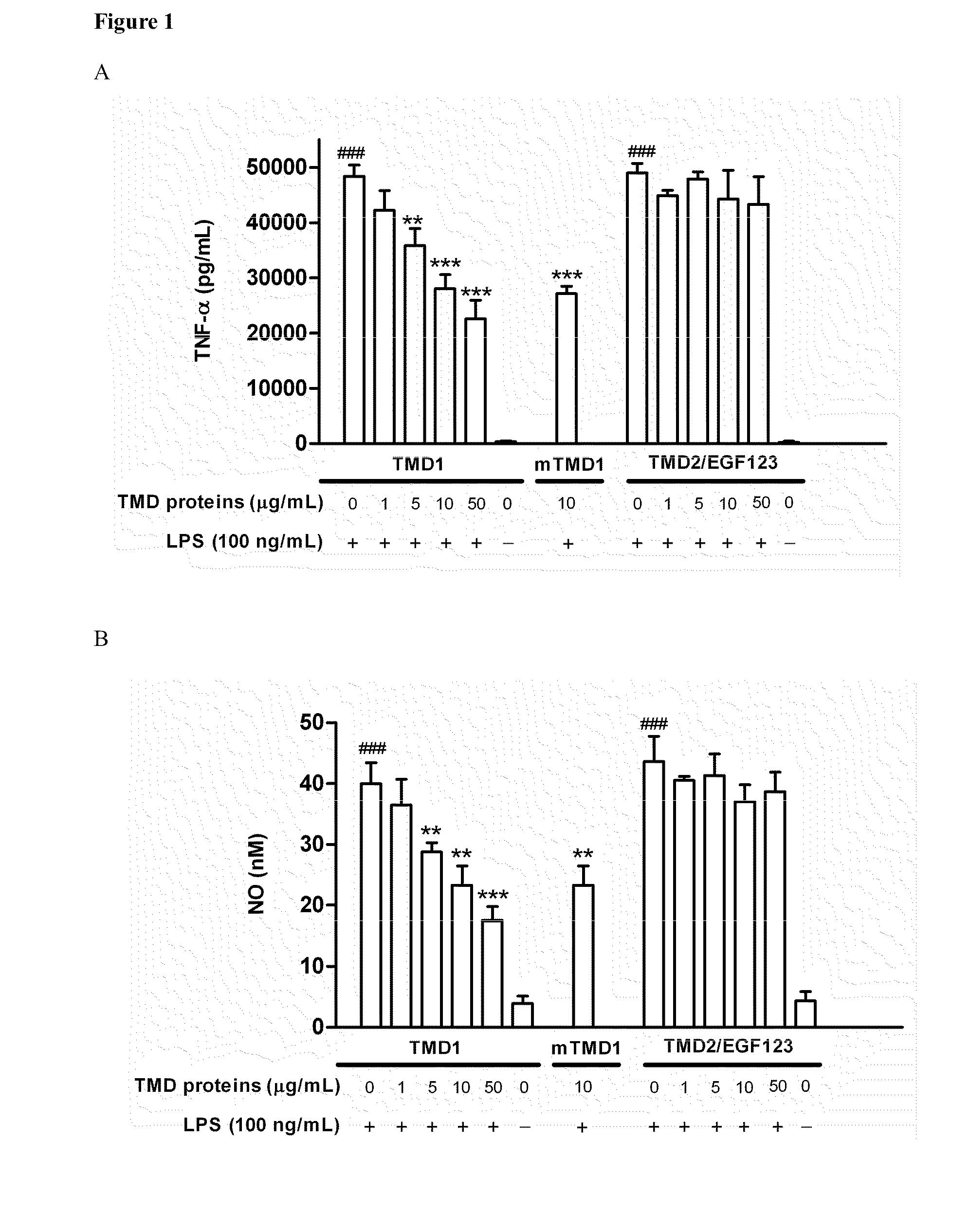Methods for binding lewis y antigen
a technology of thrombomodulin and antigen, applied in the field of lectinlike domain of thrombomodulin, can solve the problems of multiple organ failure, lethal systemic tissue damage, and death in hospitalized patients
- Summary
- Abstract
- Description
- Claims
- Application Information
AI Technical Summary
Benefits of technology
Problems solved by technology
Method used
Image
Examples
example 1
rTMD1 Treatment Reduces LPS-Induced Inflammatory Mediator Production in Macrophages
[0059]To test whether TMD1 has anti-inflammatory property, rTMD proteins were prepared by using both Pichia pastoris and mammalian protein expression systems. The rTMD1 proteins obtained from both systems had similar molecular mass with glycosylation modification, which was about 35 kDa and as assayed by silver staining and Western blotting. The anti-inflammatory effect of rTMD proteins in RAW 264.7 and THP-1 cells stimulated with LPS was tested first. Pichia-expressed rTMD1 but not recombinant TMD2 containing EGF like domain 1, 2, 3 (rTMD2 / EGF123) dose-dependently inhibited TNF-α production in RAW 264.7 cells stimulated with LPS (FIG. 1A); similar results were obtained in THP-1 cells (data not shown). Likewise, only rTMD1 could effectively inhibit NO production in RAW 264.7 cells (FIG. 1B); similar results were obtained using mammalian-expressed rTMD1 (FIG. 1A-B). To test whether the reduction of LPS...
example 2
rTMD1 Blocks the LPS-Induced Signaling Pathways
[0060]Phosphorylation and degradation of IκBα occurred in RAW 264.7 cells stimulated with LPS (100 ng / mL). The effect was totally reversed by rTMD1 (50 μg / mL, equals 2.18 nmole / mL) (FIG. 1D). The LPS-induced nuclear translocation of NF-κB was also inhibited in a dose-dependent fashion by rTMD1 (FIG. 1E). LPS-induced phosphorylation of ERK1 / 2 and p38 was also inhibited by rTMD1 (FIG. 1F). Similar effects of rTMD1 on activation of signal transduction pathway were observed in THP-1 cells (data not shown). iNOS induction in the RAW 264.7 cells by LPS was also inhibited by rTMD1 (FIG. 1G).
example 3
rTMD1 Reduces Cytokine Release, Attenuates Lung and Renal Injury, Improves Survival in Experimental Sepsis, and Enhances Bacterial LPS Clearance
[0061]Since rTMD1 could inhibit LPS-induced inflammatory mediator productions and signaling pathways, rTMD1 might function as a therapeutic agent to reduce the inflammatory response and lethality induced by LPS in vivo. TNF-α and NO levels were increased in mice 6 hours after i.p. administration of 20 mg / kg LPS, relative to control mice. Mice receiving an i.v. injection of rTMD1 (1-5 mg / kg, equals 43.66-218.3 nmole / kg) had significantly decreasing levels of TNF-α and NO (FIG. 2A-B). PMNs infiltration was evident in lung sections in LPS-treated mice 6 hours after administration of LPS (FIG. 2C-D). rTMD1 injection significantly inhibited pulmonary accumulation of PMNs 6 hours after LPS administration (FIG. 2C-D). However, rTMD2 / EGF123 had no significant effect on LPS-induced inflammatory responses and could serve as a negative control of yeast...
PUM
| Property | Measurement | Unit |
|---|---|---|
| Mobility | aaaaa | aaaaa |
Abstract
Description
Claims
Application Information
 Login to View More
Login to View More - R&D
- Intellectual Property
- Life Sciences
- Materials
- Tech Scout
- Unparalleled Data Quality
- Higher Quality Content
- 60% Fewer Hallucinations
Browse by: Latest US Patents, China's latest patents, Technical Efficacy Thesaurus, Application Domain, Technology Topic, Popular Technical Reports.
© 2025 PatSnap. All rights reserved.Legal|Privacy policy|Modern Slavery Act Transparency Statement|Sitemap|About US| Contact US: help@patsnap.com



